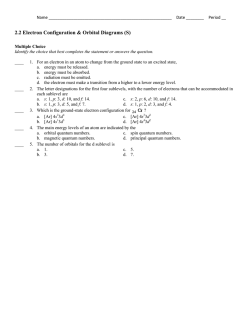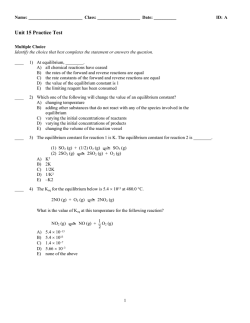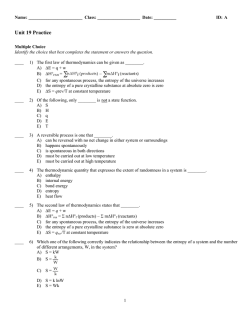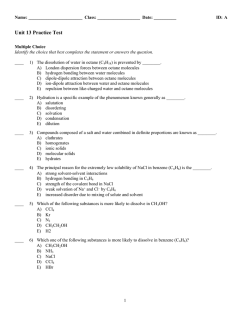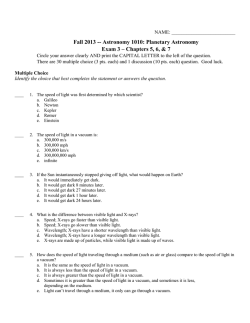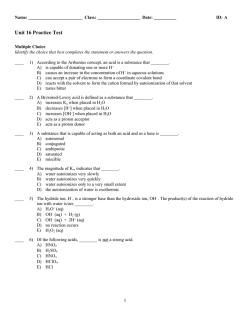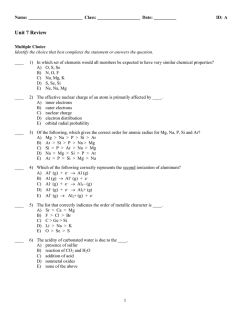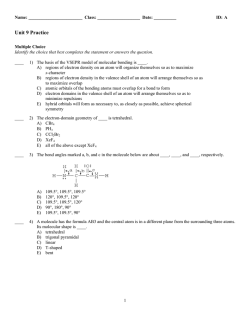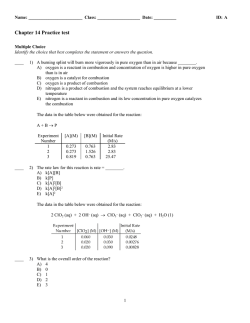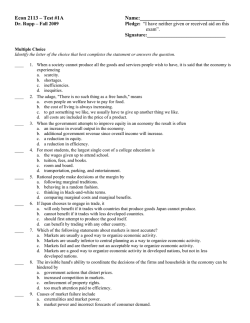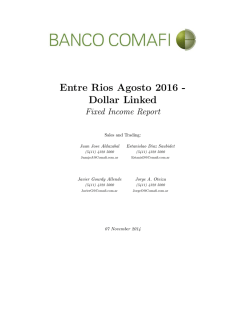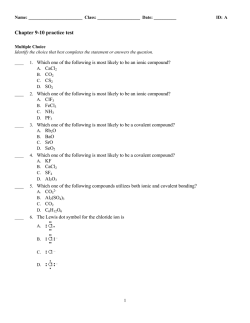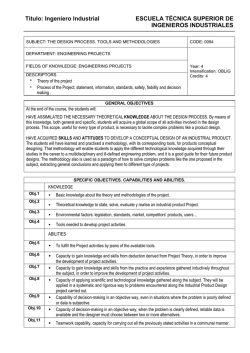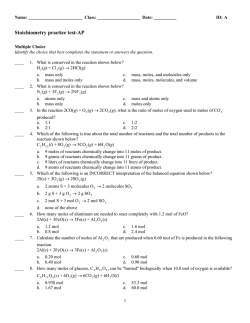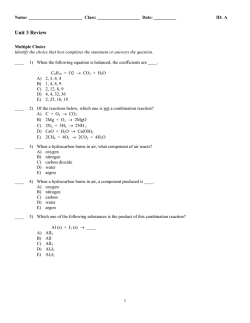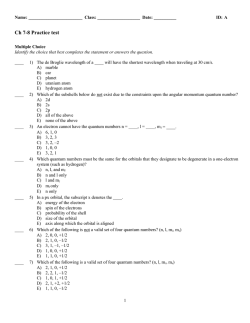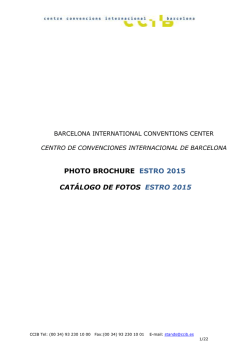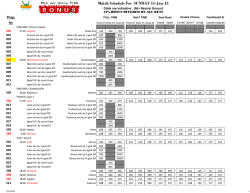
ExamView - Unit 4 Test practice.tst
Name: ________________________ Class: ___________________ Date: __________ ID: A Unit 4 Practice Test Multiple Choice Identify the choice that best completes the statement or answers the question. ____ 1) The balanced molecular equation for complete neutralization of H 2SO4 by KOH in aqueous solution is ____. A) 2H+ (aq) + 2OH– (aq) 2H2O (l) B) 2H+ (aq) + 2KOH (aq) 2H2O (l) + 2K+ (aq) C) H2SO4 (aq) + 2OH– (aq) 2H2O (l) + SO42– (aq) D) H2SO4 (aq) + 2KOH (aq) 2H2O (l) + K2SO4 (s) E) H2SO4 (aq) + 2KOH (aq) 2H2O (l) + K2SO4 (aq) ____ 2) Aqueous potassium chloride will react with which one of the following in an exchange (metathesis) reaction? A) calcium nitrate B) sodium bromide C) lead nitrate D) barium nitrate E) sodium chloride ____ 3) Aqueous solutions of a compound did not form precipitates with Cl –, Br–, I–, SO42–, CO32–, PO43–, OH–, or S2–. This highly water-soluble compound produced the foul-smelling gas H 2S when the solution was acidified. This compound is ____. A) Pb(NO3)2 B) (NH4)2S C) KBr D) Li2CO3 E) AgNO3 ____ 4) The net ionic equation for formation of an aqueous solution of NiI 2 accompanied by evolution of CO 2 gas via mixing solid NiCO3 and aqueous hydriodic acid is ____. A) 2NiCO3 (s) + HI (aq) 2H2O (l) + CO2 (g) + 2Ni2+ (aq) B) NiCO3 (s) + I– (aq) 2H2O (l) + CO2 (g) + Ni2+ (aq) + HI (aq) C) NiCO3 (s) + 2H+ (aq) H2O (l) + CO2 (g) + Ni2+ (aq) D) NiCO3 (s) + 2HI (aq) 2H2O (l) + CO2 (g) + NiI2 (aq) E) NiCO3 (s) + 2HI (aq) H2O (l) + CO2 (g) + Ni2+ (aq) + 2I– (aq) ____ 5) The net ionic equation for formation of an aqueous solution of Al(NO3)3 via mixing solid Al(OH)3 and aqueous nitric acid is ____. A) Al(OH)3 (s) + 3HNO3 (aq) 3H2O (l) + Al(NO3)3 (aq) B) Al(OH)3 (s) + 3NO3– (aq) 3OH– (aq) + Al(NO3)3 (aq) C) Al(OH)3 (s) + 3NO3– (aq) 3OH– (aq) + Al(NO3)3 (s) D) Al(OH)3 (s) + 3H+ (aq) 3H2O (l) + Al3+ (aq) E) Al(OH)3 (s) + 3HNO3 (aq) 3H2O (l) + Al3+ (aq) + NO3– (aq) 1 Name: ________________________ ID: A ____ 6) The net ionic equation for the reaction between aqueous nitric acid and aqueous sodium hydroxide is ____. A) H+ (aq) + HNO3 (aq) + 2OH– (aq) 2H2O (l) + NO3– (aq) B) HNO3 (aq) + NaOH (aq) NaNO3 (aq) + H2O (l) C) H+ (aq) + OH– (aq) H2O (l) D) HNO3 (aq) + OH– (aq) NO3– (aq) + H2O (l) E) H+ (aq) + Na+ (aq) + OH– (aq) H2O (l) + Na+ (aq) ____ 7) Which one of the following is a diprotic acid? A) nitric acid B) chloric acid C) phosphoric acid D) hydrofluoric acid E) sulfuric acid ____ 8) Which one of the following is a weak acid? A) HNO3 B) HCl C) HI D) HF E) HClO4 ____ 9) Sodium does not occur in nature as Na (s) because ____. A) it is easily reduced to Na– B) it is easily oxidized to Na+ C) it reacts with water with great difficulty D) it is easily replaced by silver in its ores E) it undergoes a disproportionation reaction to Na – and Na+ ____ 10) A 0.200 M K2SO4 solution is produced by ____. A) dilution of 250.0 mL of 1.00 M K 2SO4 to 1.00 L B) dissolving 43.6 g of K 2SO4 in water and diluting to a total volume of 250.0 mL C) diluting 20.0 mL of 5.00 M K 2SO4 solution to 500.0 mL D) dissolving 20.2 g of K 2SO4 in water and diluting to 250.0 mL, then diluting 25.0 mL of this solution to a total volume of 500.0 mL E) dilution of 1.00 mL of 250 M K 2SO3 to 1.00 L ____ 11) You are given two clear solutions of the same unknown monoprotic acid, but with different concentrations. Which statement is true? A) There is no chemical method designed to tell the two solutions apart. B) It would take more base solution (per milliliter of the unknown solution) to neutralize the more concentrated solution. C) A smaller volume of the less concentrated solution contains the same number of moles of the acid compared to the more concentrated solution. D) If the same volume of each sample was taken, then more base solution would be required to neutralize the one with lower concentration. E) The product of concentration and volume of the less concentrated solution equals the product of concentration and volume of the more concentrated solution. 2 Name: ________________________ ID: A ____ 12) ____ is an oxidation reaction. A) Ice melting in a soft drink B) Table salt dissolving in water for cooking vegetables C) Rusting of iron D) The reaction of sodium chloride with lead nitrate to form lead chloride and sodium nitrate E) Neutralization of HCl by NaOH ____ 13) What are the spectator ions in the reaction between KOH (aq) and HNO 3 (aq)? A) K+ and H+ B) H+ and OH– C) K+ and NO3– D) H+ and NO3– E) OH– only ____ 14) The balanced net ionic equation for precipitation of CaCO 3 when aqueous solutions of Na2CO3 and CaCl2 are mixed is ____. A) 2Na+ (aq) + CO32– (aq) Na2CO3 (aq) B) 2Na+ (aq) + 2Cl– (aq) 2NaCl (aq) C) Na+ (aq) + Cl– (aq) NaCl (aq) D) Ca+(aq) + CO32– (aq) CaCO3 (s) E) Na2CO3 (aq) + CaCL2 (aq) 2NaCl (aq) + CaCO3 (s) ____ 15) The spectator ions in the reaction between aqueous chloric acid and aqueous barium hydroxide are ____. A) OH– and ClO3– B) H+, OH–, ClO3–, and Ba2+ C) H+ and OH– D) H+ and Ba2+ E) ClO3– and Ba2+ ____ 16) The spectator ions in the reaction between aqueous hydrofluoric acid and aqueous barium hydroxide are ____. A) OH–, F–, and Ba2+ B) F– and Ba2+ C) OH– and F– D) Ba2+ only E) H+, OH–, F–, and Ba2+ ____ 17) Of the following elements, ____ is the only one that cannot be found in nature in its elemental form. Cu Hg Au Ag Na A) B) C) D) E) Cu Hg Au Ag Na 3 Name: ________________________ ID: A ____ 18) Of the following elements, ____ is the most easily oxidized. oxygen fluorine nitrogen aluminum gold A) B) C) D) E) oxygen fluorine nitrogen aluminum gold ____ 19) How many moles of K+ are present in 343 mL of a 1.27 M solution of K 3PO4? A) 0.436 B) 1.31 C) 0.145 D) 3.70 E) 11.1 ____ 20) Calculate the concentration (M) of sodium ions in a solution made by diluting 50.0 mL of a 0.874 M solution of sodium sulfide to a total volume of 250.0 mL. A) 0.175 B) 4.37 C) 0.525 D) 0.350 E) 0.874 ____ 21) The concentration (M) of an aqueous methanol produced when 0.200 L of a 2.00 M solution was diluted to 0.800 L is ____. A) 0.800 B) 0.200 C) 0.500 D) 0.400 E) 8.00 ____ 22) How many grams of sodium chloride are there in 55.0 mL of a 1.90 M aqueous solution of sodium chloride? A) 0.105 B) 6.11 C) 3.21 D) 6.11 103 E) 12.2 ____ 23) The molarity of a solution prepared by diluting 43.72 mL of 5.005 M aqueous K 2Cr2O7 to 500. mL is ____. A) 57.2 B) 0.0044 C) 0.438 D) 0.0879 E) 0.870 4 Name: ________________________ ID: A ____ 24) A 17.5 mL sample of an acetic acid (CH3CO2H) solution required 29.6 mL of 0.250 M NaOH for neutralization. The concentration of acetic acid was ____ M. A) 0.158 B) 0.423 C) 134 D) 6.88 E) 0.214 ____ 25) With which of the following will the Potassium ion form an insoluble salt? A) Phosphate B) Sulfate C) Sulfide D) Iodide E) Potassium will form soluble salts with all choices. ____ 26) There are ________ mol of bromide ions in 0.500 L of a 0.350 M solution of AlBr 3. A) 0.150 B) 0.0500 C) 0.525 D) 0.167 E) 0.500 ____ 27) What volume (mL) of a 5.45 M lead nitrate solution must be diluted to 820.7 mL to make a 1.41 M solution of lead nitrate? A) 212 B) 6310 C) 3170 D) 0.00936 E) 0.00471 ____ 28) How many milliliters of a stock solution of 11.7 M HNO 3 would be needed to prepare 0.500 L of 0.500 M HNO3? A) 0.0468 B) 21.4 C) 2.93 D) 46.8 E) 0.0214 ____ 29) Pure acetic acid (HC2H3O2) is a liquid and is known as glacial acetic acid. Calculate the molarity of a solution prepared by dissolving 20.00 mL of glacial acetic acid at 25 °C in sufficient water to give 500.0 mL of solution. The density of glacial acetic acid at 25 °C is 1.05 g/mL. A) 2.52 103 B) 42.0 C) 0.0420 D) 0.699 E) 6.99 10–4 5 Name: ________________________ ID: A ____ 30) What mass (g) of CaF2 is formed when 30.4 mL of 0.438 M NaF is treated with an excess of aqueous calcium nitrate? A) 0.520 B) 1.04 C) 1040 D) 0.171 E) 5420 ____ 31) A 24.5 mL aliquot of 0.0938 M H 2SO4 (aq) is to be titrated with 0.0295 M NaOH (aq). What volume (mL) of base will it take to reach the equivalence point? A) 156 B) 0.136 C) 77.9 D) 39.0 E) 4430 Numeric Response 1) How many grams of CH3OH must be added to water to prepare 175 mL of a solution that is 1.0 M CH 3OH? 2) There are ________ mol of bromide ions in 0.700 L of a 0.400 M solution of AlBr 3. 3) How many moles of Co2+ are present in 0.300 L of a 0.500 M solution of CoI 2? Short Answer 1) The solvent in an aqueous solution is ________. True/False Indicate whether the statement is true or false. ____ 1) Ca(OH)2 is a strong base. ____ 2) The compound HClO4 is a weak acid. ____ 3) HNO2 is a strong acid. ____ 4) The compound NH4Cl is a weak acid. ____ 5) Ammonia is a strong base. 6 ID: A Unit 4 Practice Test Answer Section MULTIPLE CHOICE 1) ANS: OBJ: 2) ANS: OBJ: 3) ANS: OBJ: 4) ANS: OBJ: 5) ANS: OBJ: 6) ANS: OBJ: 7) ANS: OBJ: 8) ANS: OBJ: 9) ANS: OBJ: 10) ANS: OBJ: 11) ANS: OBJ: 12) ANS: OBJ: 13) ANS: OBJ: 14) ANS: OBJ: 15) ANS: OBJ: 16) ANS: OBJ: 17) ANS: OBJ: 18) ANS: OBJ: 19) ANS: OBJ: 20) ANS: OBJ: 21) ANS: OBJ: E 4.2-4; G2 C 4.2-4; G2 B 4.2-4; G2 C 4.2-4; G2 D 4.2-4; G2 C 4.2-4; G2 E 4.1, 4.3; G2 D 4.1, 4.3; G2 B 4.2-4; G2 C 4.5; G4 B 4.5; G4 C 4.2-4; G2 C 4.2-4; G2 D 4.2-4; G2 E 4.2-4; G2 D 4.2-4; G2 E 4.2-4; G2 D 4.2-4; G2 B 4.5; G4 D 4.5; G4 C 4.5; G4 PTS: 1 DIF: 1 REF: Page Ref: 4.2 PTS: 1 DIF: 2 REF: Page Ref: 4.2 PTS: 1 DIF: 3 REF: Page Ref: 4.2 PTS: 1 DIF: 4 REF: Page Ref: 4.2 PTS: 1 DIF: 4 REF: Page Ref: 4.2 PTS: 1 DIF: 3 REF: Page Ref: 4.2 PTS: 1 DIF: 2 REF: Page Ref: 4.3 PTS: 1 DIF: 1 REF: Page Ref: 4.3 PTS: 1 DIF: 2 REF: Page Ref: 4.4 PTS: 1 DIF: 3 REF: Page Ref: 4.5 PTS: 1 DIF: 2 REF: Page Ref: 4.5 PTS: 1 DIF: 2 REF: Page Ref: 4.4 PTS: 1 DIF: 2 REF: Page Ref: 4.2 PTS: 1 DIF: 3 REF: Page Ref: 4.2 PTS: 1 DIF: 3 REF: Page Ref: 4.2 PTS: 1 DIF: 2 REF: Page Ref: 4.2 PTS: 1 DIF: 2 REF: Page Ref: 4.4 PTS: 1 DIF: 3 REF: Page Ref: 4.4 PTS: 1 DIF: 3 REF: Page Ref: 4.5 PTS: 1 DIF: 2 REF: Page Ref: 4.5 PTS: 1 DIF: 2 REF: Page Ref: 4.5 1 ID: A 22) ANS: OBJ: 23) ANS: OBJ: 24) ANS: OBJ: 25) ANS: OBJ: 26) ANS: OBJ: 27) ANS: OBJ: 28) ANS: OBJ: 29) ANS: OBJ: 30) ANS: OBJ: 31) ANS: OBJ: B 4.5; G4 C 4.5; G4 B 4.6; G4 E 4.2-4; G2 C 4.5; G4 A 4.5; G4 B 4.5; G4 D 4.5; G4 A 4.6; G4 A 4.6; G4 PTS: 1 DIF: 3 REF: Page Ref: 4.5 PTS: 1 DIF: 2 REF: Page Ref: 4.5 PTS: 1 DIF: 3 REF: Page Ref: 4.6 PTS: 1 DIF: 1 REF: Page Ref: 4.2 PTS: 1 DIF: 3 REF: Page Ref: 4.5 PTS: 1 DIF: 3 REF: Page Ref: 4.5 PTS: 1 DIF: 3 REF: Page Ref: 4.5 PTS: 1 DIF: 4 REF: Page Ref: 4.5 PTS: 1 DIF: 4 REF: Page Ref: 4.5 PTS: 1 DIF: 4 REF: Page Ref: 4.6 PTS: 1 OBJ: 4.5; G4 2) ANS: 0.840 DIF: 3 REF: Page Ref: 4.5 PTS: 1 OBJ: 4.5; G4 3) ANS: 0.150 DIF: 3 REF: Page Ref: 4.5 PTS: 1 OBJ: 4.5; G4 DIF: 3 REF: Page Ref: 4.5 DIF: 1 REF: Page Ref: 4.1 NUMERIC RESPONSE 1) ANS: 5.6 SHORT ANSWER 1) ANS: water PTS: 1 OBJ: 4.1, 4.3; G2 2 ID: A TRUE/FALSE 1) ANS: OBJ: 2) ANS: OBJ: 3) ANS: OBJ: 4) ANS: OBJ: 5) ANS: OBJ: T 4.1, 4.3; G2 F 4.1, 4.3; G2 F 4.1, 4.3; G2 T 4.1, 4.3; G2 F 4.1, 4.3; G2 PTS: 1 DIF: 1 REF: Page Ref: 4.3 PTS: 1 DIF: 2 REF: Page Ref: 4.3 PTS: 1 DIF: 1 REF: Page Ref: 4.3 PTS: 1 DIF: 2 REF: Page Ref: 4.3 PTS: 1 DIF: 1 REF: Page Ref: 4.3 3 Unit 4 Practice Test [Answer Strip] C _____ 6) E _____ 1) E _____ 7) C _____ 2) D _____ 8) C 12) _____ ID: A D 18) _____ C 13) _____ E 25) _____ D 14) _____ B _____ 3) B 19) _____ D 20) _____ B _____ 9) E 15) _____ C 10) _____ D 16) _____ C _____ 4) B 11) _____ B 24) _____ E 17) _____ C 21) _____ B 22) _____ D _____ 5) C 23) _____ C 26) _____ A 27) _____ B 28) _____ D 29) _____ Unit 4 Practice Test [Answer Strip] A 30) _____ A 31) _____ T _____ 1) F _____ 2) F _____ 3) T _____ 4) F _____ 5) ID: A
© Copyright 2024
